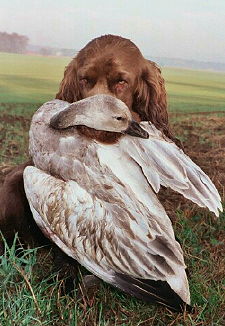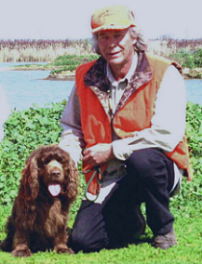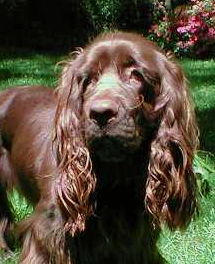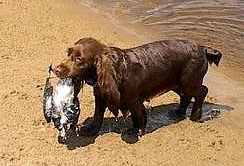


|
Clementine - photo courtesy of Michael Globetti
|
Over the last year, two Sussex Spanielsóa dog and a bitchóbecame AKC Master Hunters. Not a big deal, you say. Well actually, it is a huge deal. Not for any lack of breed capability, but more due to a lack of opportunity, did "Satch" and "Clemmie" earn the first MH titles in the United States. Iím convinced that they will not be the last. If you havenít already seen one of these ďlittle brown dogsĒ out hunting, chances are you may in the near future. So, letís review a bit of the ins-and-outs of one of the rarest spaniel breeds.
The Sussex Spaniel was developed as a breed in the county of itís namesake, Sussex, in southern England. By all accounts, it was recognized as a distinct breed as early as the late eighteenth century. But the breed really developed, in a modern sense, during the last quarter of the nineteenth century. One gentleman stands out in my mind as solidifying the Sussex as a dual-purpose dog and quite possibly ensuring the very survival of the Sussex into the 20th century. Mr. Campbell Newington, breeding under the name of Rosehill, was, in addition to being one of the landed gentry, a sportsman whose main objective with regard to Sussex was to produce a good working gun dog without compromising the standard. There have never been large numbers of Sussex and over time the breed has had to rely on a handful of enthusiasts to keep the breed from becoming extinct.
Like many of the minor breeds, the two World Wars took their toll and by the end of World War II, only a handful of Sussex remained on English soil. Although there were Sussex in the US at the time, none of those lines remain; all of the dogs throughout the world today trace their lineage back to six of Ms. Joy Freerís (recognized as the savior of the Sussex) eight dogs that survived through the war years.
The Sussex gained a solid foothold here in America during the early 1970ís and since that time their numbers have grown, albeit slowly. Last year, only 92 Sussex were registered in the US. This year the numbers are likely to be significantly less.
|
Satch - photo courtesy of Don Krueger
|
The majority of Sussex in the US are kept as companion dogs or they make the show circuit. There are just a few dedicated individuals - you can probably count them on one hand - who have hunted with them or tested their skills in hunt tests. There are only nine Sussex who currently have an AKC hunt title. While it is a rare sight to see a Sussex out in the field, that certainly does not mean that they canít hunt. If given exposure to birds and the opportunity, they can be dependable bird dogs. There is currently no show/field split in the breed and, hopefully, none will develop. Virtually all of the dogs currently out in the field, however, have strong English lines in their pedigrees.
The landowners of Sussex bred and perfected a gundog to hunt without tiring in the thickly wooded forests, billows of foliage, and deep hedgerows of the Sussex Weald. Often referred to as "little brown dogs", in actuality they are nothing of the sort. The Sussex is a strong, powerful dog. It may be short in stature measuring 13-15 inches at the withers in the US and 14-16 inches in England and elsewhere. They are a heavily boned and muscular dog weighing between 35 and 45 pounds at maturity. Coupled with their long-low-level and rectangular outline makes them an extremely powerful dog for finding and flushing game in thick, heavy cover. The rich, golden liver color is the only color of a true Sussex. Sunlight and maturity will highlight this beautiful feature of the breed. Their coats ideally should be flat, straight and "seal-like" with ample undercoat
to protect them from chilly waters - even after a prolonged swim.
Sussex are extremely smart dogs and are absolute masters at making you believe otherwise. Their expressions are almost human-like and their silly antics will make you laugh. A Sussex grin will win your heart. In addition to being clever, they are single minded and stubborn - giving way to a challenging training scenario. They do not take well to harsh training methods and therefore, patience is a must. A good sense of humor is most helpful. However, too much repetition in training and they will decidedly become rather bored and tired with the entire process. Also, once exposed to real birds, training dummies donít elicit the same excitement and you may find training even more of a challenge. Some creative learning will probably become a necessity. Natural retrieving ability seems to be a mixed bag with the breed; part of the problem is that they
just may not see the need when, in their minds, you are more than capable of shagging game - particularly after they have carried it out of the thick brush and into the open for you! Sussex are a slow maturing breed and may not be ready for some complex skills until much later than you are accustomed to with an English Springer. Sorry fellaís but the girls seem to be quicker learners and in general, more indefatigable hunters. Although not at all common, the occasional Sussex may give tongue when prey is located and this should not be penalized; in thick cover it could be, in fact, quite a useful trait.
Their hunting style is methodical and determined. Frank Komatar, who has hunted over Sussex in the US for over 20 years, best describes them: "First, they are an extremely thorough hunter. I canít remember the last time I got to flush a bird when hunting with a Sussex. When a Sussex covers an area, any and all birds in the area have been flushed. The biggest surprise Iíve had with the breed is their overall toughness and endurance."
Sussex are not flashy hunters nor do they speed through the cover, but they do work quickly and purposefully. They are in no way slow, plodding, or clumsy. If you can see them in the cover, you will know immediately when they have the scent of bird as their docked tail will became so fantastically animated youíd think they would gyrate themselves into the air! Once the scent is detected and the bird located, they may pause briefly (but not in an indecisive manner) before performing a strong, forceful flush. Sussex enjoy the water and they should have no problem performing good, solid water retrieves. It might actually be more of a problem keeping them out of every water (or mud) hole you come across; but they arenít just clowning around, they are more than likely cooling themselves off and keeping themselves from overheating.
|
"Sussex are extremely smart dogs and are absolute masters at making you believe otherwise."
|
|
Choosing a Sussex puppy is probably easier than finding a Sussex puppy. Over the past seven years, AKC breed registrations have fluctuated from 56 to 108 dogs. You may be fortunate enough to have fate on your side and find a Sussex quickly but more often than not, you will wait and hope for a year or longer. Sussex are not easy reproducers. Missed breedings and difficult whelps seem to be commonplace - and this has kept the breed rare on both sides of the Atlantic. Although as mentioned, there is no field/show split in the breed, Iím not sure itís pure coincidence that virtually all of the dogs out in the field today have strong recent ties to English lines. As some may have you believe, this is because the English Sussex are higher on the leg (14-16 inches) and are, therefore, better field dogs but I favor the view that itís due to the fact that the
Sussex in England are worked in the beating line more than our US Sussex are worked in the field and that working ability has been better upheld.
Sussex were bred for the gun and to work with their owners. In doing so, they should have a "cheerful, tractable disposition". Socialization to everything at a young age is critical and, in my opinion, Sussex excel in a home rather than a kennel environment. They are, after all, people-focused dogs. If not checked, they can be over protective of everything (toys, food, their house) and everyone they deem as theirs. You must be able to assert yourself as "top dog" or they will take over. Obedience training is imperative to thoroughly enjoy a Sussex as a hunting and household companion. Most owners of Sussex spaniels will privately admit that they are, in fact, really owned by their Sussex!
Despite what is often referred to as the "gene puddle" from which the breed can trace its lineage, they are a relatively healthy lot. The most serious health concerns are heart-related. In addition, some deafness and eye-related problems exist. Dysplasia is common in this breed but most often not debilitating.
The Sussex Spaniel Club of America is the official AKC parent club of the breed and more information can be found on their website www.sussexspaniels.org. To generate interest in field work - the basis of the breed - the club has held a special field day in conjunction with our last three National Specialties. This year the SSCA will hold its first licensed hunt test for all spaniels on July 31/August 1st at the Lower Wisconsin River Wildlife Area, Mazomanie, Wisconsin. A full premium can be downloaded from the clubís website.

|
Ann McGloonís involvement with Sussex spaniels began in 1999. She has been active in breed research - her database of Sussex in America can be found on the SSCA website - and promoting Sussex in the field. She owns Ch. Stonecroft Cosenza, WD, CGC aka "Connie", only the second Sussex female to have both a championship title and a field certificate, her dam being the other. Ann breeds under the kennel name ShootingStar and can be contacted at:
|
|






